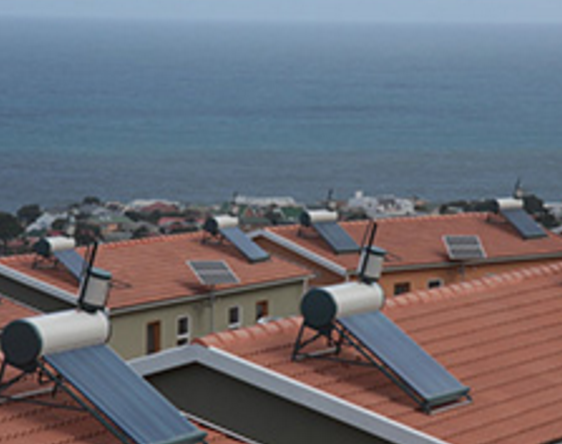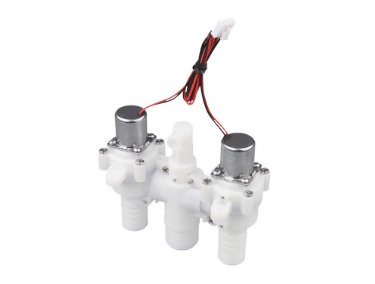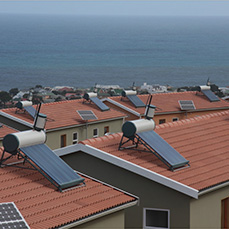Solar water heater, electromagnetic valve, is like a switch when the sensors detect the casing water level is lower than the set water level, the motherboard will provide + 12 v voltage for electromagnetic valve when getting the voltage solenoid valve coil, the electromagnetic valve opens, as the solar energy water, when the sensor detects the water tank water level to set, the mainboard will stop to power a solenoid valve, solenoid valve closed, water stop.

The principle of electromagnetic valve control solar energy water heater water use is a common engineering language, a control circuit is simple, automatic water can add a level electrode in solar energy (use galvanized round steel or stainless steel), on two electrodes series connected to 24 VDC power supply positive, external a 24 VDC relays, relay control solenoid valve. Two electrodes one long (lower limit) and one short (upper limit), when the water level is a lower limit, that is, the water does not overspread the long electrode, the relay is not electricity, solenoid valve open water. When the water level rises to the upper limit two electrodes pass through the water, the relay receives electricity, the solenoid valve closes, and the water is stopped. You can also use the float switch to control the automatic water, so the circuit is simple, as long as the power line on the float switch, through the switch control relay, and then by the relay control solenoid valve. The principle the water surface reaches the upper limit float switch disconnects, the relay loses power disconnects the solenoid valve, the lower limit float switch connects the relay gets the power to connect the solenoid valve.
The function of the solenoid valve is to make the pipe check or directional flow, solenoid valve in the solar water heater water when it opens, let the cold water into the tank when the water stopped when the solenoid valve closed, then the solar water tank water can not flow back through the solenoid valve into the cold water pipe. If the solenoid valve is still closed when the water in the heater is used, the water can only flow into the hot water pipe and not into the cold water pipe. Generally speaking, the solenoid valve and the solar instrument are used together and should be fully automatic control, so it is not necessary to control the solenoid valve separately when testing the solar water heater.
The solar solenoid valve is divided into pressure and no pressure two, if the cold water pressure is relatively small it is best to choose no pressure valve, or the solenoid valve may not open, can not normally water; If the water pressure is larger, choose to have pressure valve, otherwise, the solenoid valve may not check, that is to say, the water in the water heater may be backflow into the cold water pipe or the solenoid valve cannot close, causing the water heater temperature rise not up.
1. Electrical safety parameter tester high voltage: 0 ~ 5000V, insulation resistance: 100 (500V)
2. Universal meter
3. The voltage regulator
4. A stopwatch
5. Flow rate and pressure of leakage test bench: 0 ~ 2Mpa flow rate: 0 ~ 20L/Min

1. Visual inspection of appearance: the overall size meets the requirements, with complete parts and components, and the surface of metal parts is free of rust, casting sand holes and other obvious defects; There is no cracking and deformation on the surface of plastic parts, and there should be no exposed bottom, cracks, obvious bubbles and shrinkage holes in the coating layer. The sign is clear.
2. The coil resistance is measured with the multimeter resistance file, and the normal value is 55%K
3. Start by applying a voltage of 187V, a test voltage of 50Hz and water pressure of 0.8mpa to both ends of the coil through the voltage regulator, the upper water solenoid valve should be able to start and close reliably.
4. Connect the solenoid valve in the marked direction to the flow rate and leakage test bench and apply the rated voltage at 0.1mpa water pressure for 1 minute. The flow rate shall be greater than 8& NBSP; L/Min. At the pressure of 0.02mpa, the rated voltage should be applied, lasting for 1 minute, and the flow rate should be greater than 3L/Min.
5. Water-resistant connect the solenoid valve to the flow and leakage testbed in the marked direction, turn off the power supply of the valve, and apply 0.6mpa water pressure for 5 minutes. There is no leakage or leakage except the outlet of the solenoid valve. Last for 1 minute without any leakage, the leakage amount of outlet is less than 0.1 ml. Connect the solenoid valve in the opposite direction to the flow rate and leakage test bench, turn off the power supply of the valve, and apply the pressure of 0.003mpa for 5 minutes. There shall be no leakage or leakage of the solenoid valve.
6. For insulation resistance, use 500V megohmmeter or insulation resistance tester with an error of no more than 5%. The insulation resistance between the conductive part and the exposed non-live metal part shall be more than 100M
7. Electric safety parameter tester for electrical strength: apply 50Hz, 2500 5%V ac voltage between the conductive part and the non-charged metal part of the solenoid valve for 1 minute, and there shall be no flashover or breakdown.
8. Soak the solenoid valve in a water tank with a water depth of 10-1 and water temperature of 20-10℃ for 8 hours; After taking out, wipe away the surface water, and measure the insulation resistance more than 2M after 2 hours.

Previous: Application for the Irrigation Solenoid valve
Next: Washing Machine Valve